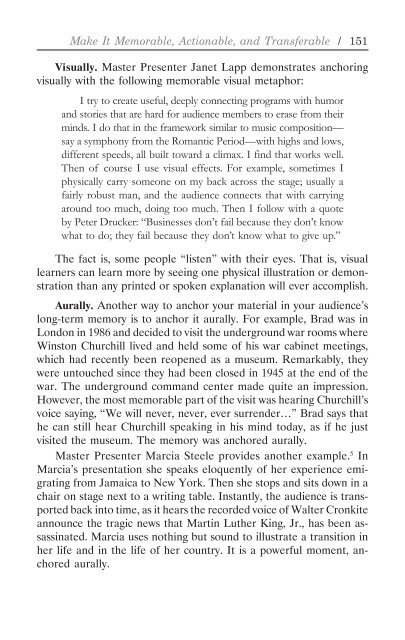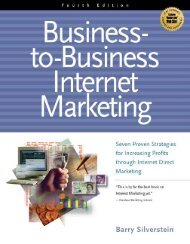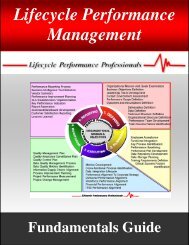The Seven Strategies of Master Presenters - Lifecycle Performance ...
The Seven Strategies of Master Presenters - Lifecycle Performance ...
The Seven Strategies of Master Presenters - Lifecycle Performance ...
You also want an ePaper? Increase the reach of your titles
YUMPU automatically turns print PDFs into web optimized ePapers that Google loves.
Make It Memorable, Actionable, and Transferable / 151<br />
Visually. <strong>Master</strong> Presenter Janet Lapp demonstrates anchoring<br />
visually with the following memorable visual metaphor:<br />
I try to create useful, deeply connecting programs with humor<br />
and stories that are hard for audience members to erase from their<br />
minds. I do that in the framework similar to music composition—<br />
say a symphony from the Romantic Period—with highs and lows,<br />
different speeds, all built toward a climax. I find that works well.<br />
<strong>The</strong>n <strong>of</strong> course I use visual effects. For example, sometimes I<br />
physically carry someone on my back across the stage; usually a<br />
fairly robust man, and the audience connects that with carrying<br />
around too much, doing too much. <strong>The</strong>n I follow with a quote<br />
by Peter Drucker: “Businesses don’t fail because they don’t know<br />
what to do; they fail because they don’t know what to give up.”<br />
<strong>The</strong> fact is, some people “listen” with their eyes. That is, visual<br />
learners can learn more by seeing one physical illustration or demonstration<br />
than any printed or spoken explanation will ever accomplish.<br />
Aurally. Another way to anchor your material in your audience’s<br />
long-term memory is to anchor it aurally. For example, Brad was in<br />
London in 1986 and decided to visit the underground war rooms where<br />
Winston Churchill lived and held some <strong>of</strong> his war cabinet meetings,<br />
which had recently been reopened as a museum. Remarkably, they<br />
were untouched since they had been closed in 1945 at the end <strong>of</strong> the<br />
war. <strong>The</strong> underground command center made quite an impression.<br />
However, the most memorable part <strong>of</strong> the visit was hearing Churchill’s<br />
voice saying, “We will never, never, ever surrender…” Brad says that<br />
he can still hear Churchill speaking in his mind today, as if he just<br />
visited the museum. <strong>The</strong> memory was anchored aurally.<br />
<strong>Master</strong> Presenter Marcia Steele provides another example. 5 In<br />
Marcia’s presentation she speaks eloquently <strong>of</strong> her experience emigrating<br />
from Jamaica to New York. <strong>The</strong>n she stops and sits down in a<br />
chair on stage next to a writing table. Instantly, the audience is transported<br />
back into time, as it hears the recorded voice <strong>of</strong> Walter Cronkite<br />
announce the tragic news that Martin Luther King, Jr., has been assassinated.<br />
Marcia uses nothing but sound to illustrate a transition in<br />
her life and in the life <strong>of</strong> her country. It is a powerful moment, anchored<br />
aurally.










